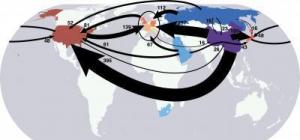
Where do a country’s carbon emissions come from? The most logical inclination would be that a country’s measured carbon emissions originate solely in the geographical confines of that nation; however, a recent study at the Carnegie Institution has found evidence to the contrary. The research done by the scientists at Carnegie indicates that over a third of carbon emissions of developed countries is actually emitted in less developed countries such as India and China.

In the case of the United States, the study found that, “per person, about 2.5 tons of carbon dioxide are consumed in the U.S. but produced somewhere else.” (Carnegie) With the recent promises made by the U.S. and the other nations that partook in the Copenhagen Accord, it is important to consider this ‘outsourcing’ when formulating and implementing environmental policy as opposed to referencing solely domestic emissions.
The data was derived from tracking commonly used products in 57 industry sectors across 113 countries. Researcher and lead author Steven Davis better described the ‘outsourcing’ phenomenon as being “just like the electricity that you use in your home probably causes CO2 emissions at a coal-burning power plant somewhere else.”
As conscientious citizens of the planet, it is important to understand how our actions effect the environment in which we live. When determining your own carbon footprint, it is important to keep in mind that the choices you make and the products and services that you consume can all have a significant impact on carbon emissions, both in and out of the nation’s borders.